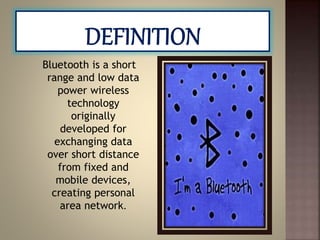Bluetooth (Information Technology)
- 2. Bluetooth is a short range and low data power wireless technology originally developed for exchanging data over short distance from fixed and mobile devices, creating personal area network.
- 3. Bluetooth wireless technology (BWT) was developed in 1994 at Ericsson Sweden. It is named for Harald Blaatand. It is standard of IEEE 802.15.1. Bluetooth is a technology that connect and transmit voice and data to computer, mobile phones and other devices without using of wires. Bluetooth make wireless communication and networking between devices in a small localized area that range from 1 meters to 10 meters. Bluetooth technology removes the need for numerous and inconvenient cable attachments.
- 4. Bluetooth mainly came into being as a solution to the cumbersome problem of cables and it was convinced as a cable replacement technology. It was mainly built for providing a short range wireless solution to the consumers.
- 5. Have you ever imagined how the name Bluetooth relates to the technology? INTERESTING STORY In 1994 Bluetooth was developed by Ericsson which is a Danish company. They named it after a Danish king, whose nickname was Bluetooth because he brought the Danish tribes together.
- 6. Bluetooth uses something called frequency hopping spread spectrum , which is a radio technology. Frequency hopping spread spectrum (FHSS) is a technique of transmitting radio signals by hopping or changing a carrier among vary frequency channels, using some sequence which is known to both transmitter and receiver.
- 7. Bluetooth uses a network topology called a piconet. When a piconet is formed between two or more devices, one device take a role of “master” and all other devices assume “slave”. Piconets contain a minimum of two and maximum of 8 Bluetooth devices. MASTER SLAVE SLAVE SLAVE SLAVE
- 9. WIRELESS :- Bluetooth works without cable, it works with wireless. LOW ENERGY CONSUMPTION:- Bluetooth uses low power signals. For that reason technology need little energy. And will use less battery. BLUETOOTH TECHNOLOGY IS INEXPENSIVE :- Bluetooth is cheap to manufacture, and anyone can buy it. SHARING VOICE AND DATA :- The Bluetooth allows to devices to share voice and data communications.
- 10. DATA TRANSFER RATE :- Bluetooth has a low data rate (i.e. 1MBps) in comparison to infrared (i.e. 4MBps). RANGE :- Bluetooth only has a range of 15 to 30 feet depending on the device. The small range is a disadvantage for some who may want to use a Bluetooth device outside of that 30-foot radios. Where there are a number of mobile device in the same room, and possibly attempting the same operation. Since Bluetooth is Omni-directional, It encounters problems in discovering the intended recipient device.
- 11. Connect your wireless headset to your mobile phone, mobile computer or any wired connection to keep your hands free for more important tasks when you are at office or in your car. By installing a Bluetooth network in office, you can do away with the complex task of networking between the computing devices. Each Bluetooth device could be connected to 200 other devices. It supports both point to point and point to multipoint connections. The Bluetooth technology connects all your peripherals wirelessly. Connect to computers or printers, scanners and other devices without the trouble of cable attachments.
- 12. In conclusion, Bluetooth is a wireless technology that will make connections between various devices. Bluetooth technology takes away the need for several problematic cable attachments for connecting mobile phones, handheld devices and computers. It is easy simple and inexpensive. It’s best way to communicate…
- 13. THANKYOU FOR YOUR TIME AND CONCERN













